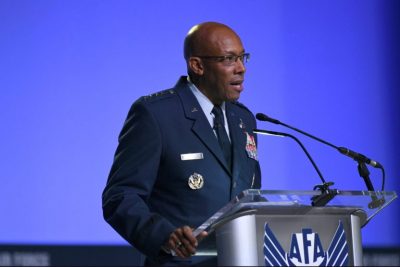We Are Out Of Time, China Has Caught Up – US General
The Air Force’s futurist has an alarming message for Congress: “We are out of time.”
Lt. Gen. S. Clinton Hinote, deputy chief of staff for strategy, integration, and requirements told reporters at the start of the Air Force Association’s Air, Space & Cyber Conference on Sept. 20, the Department needs to modernize its forces now, divest equipment that won’t stand up in a high-end fight, or face the reality that defeat is inevitable.
“As somebody who is cognizant of the evidence at all classification levels, cognizant of what’s going on in our exercises … or training, I believe the light is blinking red,” Hinote said. “Why? Because it used to be that when we did future war games, we were having trouble when we set the war game five, 10, 15 years out into the future. … It used to be a future problem. But what has changed since the last time we sat in this building two years ago, is that it’s not a future problem. … It is a current problem.”
Chief of Staff Gen. Charles Q. Brown Jr. in his keynote address said China’s People’s Liberation Army has the largest aviation forces in the Indo-Pacific, the largest conventional missile capability in the world, and is actively fielding hypersonic missiles. China also is establishing bases around the globe, often times in places where the U.S. already has a presence.
China has said its armed forces will be fully modernized by 2035 and “world class by 2050,” said Brown, who noted that, “China continues to move its modernization timelines left at a rate of of change that is outpacing the United States.”
“The day after the last C-17 left Kabul, I was in the Indo-Pacific where a graver threat is manifesting; where the risk and stakes are high,” Brown said. “We must move with a sense of urgency today in order to rise to the challenges of tomorrow, because the return to strategic competition is one of our nation’s greatest challenges. Strategic competition may not be as stark or obvious as a 9/11-like event, but it can be just as catastrophic. We cannot wait for a catastrophic crisis, whether it be sudden or insidious, to drive change for the Air Force and the joint force. If we do, it will be too late.”
Hinote said the Air Force is not having success in war games fought with today’s technology.
“The people we would use tonight, the platforms we would use tonight, are not going well,” Hinote said. “What we’re finding is that in key areas of the competition between China and the United States, … we’re pairing. In a few important areas, we’re behind—tonight. This is not a tomorrow problem. This is a today.”
Hinote didn’t elaborate on the areas where the U.S. is losing to China, but he did highlight what the Department plans to do about it. It must:
Modernize its two legs of the nuclear triad. For the Air Force, this includes the Ground Based Strategic Deterrent to replace the aging Minuteman III intercontinental ballistic missile and bringing on the new B-21 bomber.
Divest equipment that won’t stand up against a peer competitor like China. Hinote says the service can no longer afford to maintain seven fighter fleets, and must reduce the force to just four fleets. USAF wants to modernize the F-22 Raptor until the Next Generation Air Dominance platform comes online; the F-35 strike fighter will serve as the backbone of the fighter fleet, the F-15E and F-15EX (which he called a 4.5 or 4.6-generation aircraft) will replace legacy C- and D-variants, and a modernized F-16 is needed for the homeland defense mission.
Expand Aerial Refueling Capability. Hinote views tankers as a three-step process. The KC-46 Pegasus, once dubbed KC-X, will fill a void in the short term, while the KC-Y will take advantage of existing technology to relieve some of the pressure on the service’s KC-135 fleet in the near-term. KC-Z will be the developmental tanker and will consider things like stealth, speed, and whether it is a manned or unmanned platform, Hinote added.
Invest in artificial intelligence. “We are going to need development pathways to field large amounts of autonomous—not just unmanned but fully autonomous—systems,” Hinote said. “That is part of our future.”
But Hinote acknowledged the Department of the Air Force can’t make these changes on its own. It not only needs buy in from important stakeholders like Congress, the administration, and internal parties within the Department of Defense, but they all need to be on the same page about the need for change and the pace of that change.
“We haven’t had that yet. That’s just the honest truth,” Hinote acknowledged.
That’s why he repeatedly called the Air, Space & Cyber Conference the “most consequential conference that I have been part of,” saying the Department doesn’t plan to waste this opportunity to raise its voice and get its message out.
“I am very concerned about the direction of our force,” Hinote said. “I lead the part of the Air Force that’s called Air Force futures. We call ourselves the voice of tomorrow’s Airmen. I am concerned that tomorrow’s Airmen will not have what they need to defend the nation in their time, if we don’t change now. We are out of time.”
In addition to changing Air Force culture, Brown said the service must also change its relationship to industry, echoing the need to make a compelling case to external stakeholders to accelerate change, using “defensible analysis and evidence” to back up its case.
“We will succeed in this endeavor only through cooperation of both traditional and emerging industry opportunities to streamline processes and incentivize intelligent risk taking,” he said. “If we do not get our relationship with industry correct, we’ll end up with fifth-generation fighters shooting fourth-generation weapons against a sixth-generation threat,” Brown cautioned.


